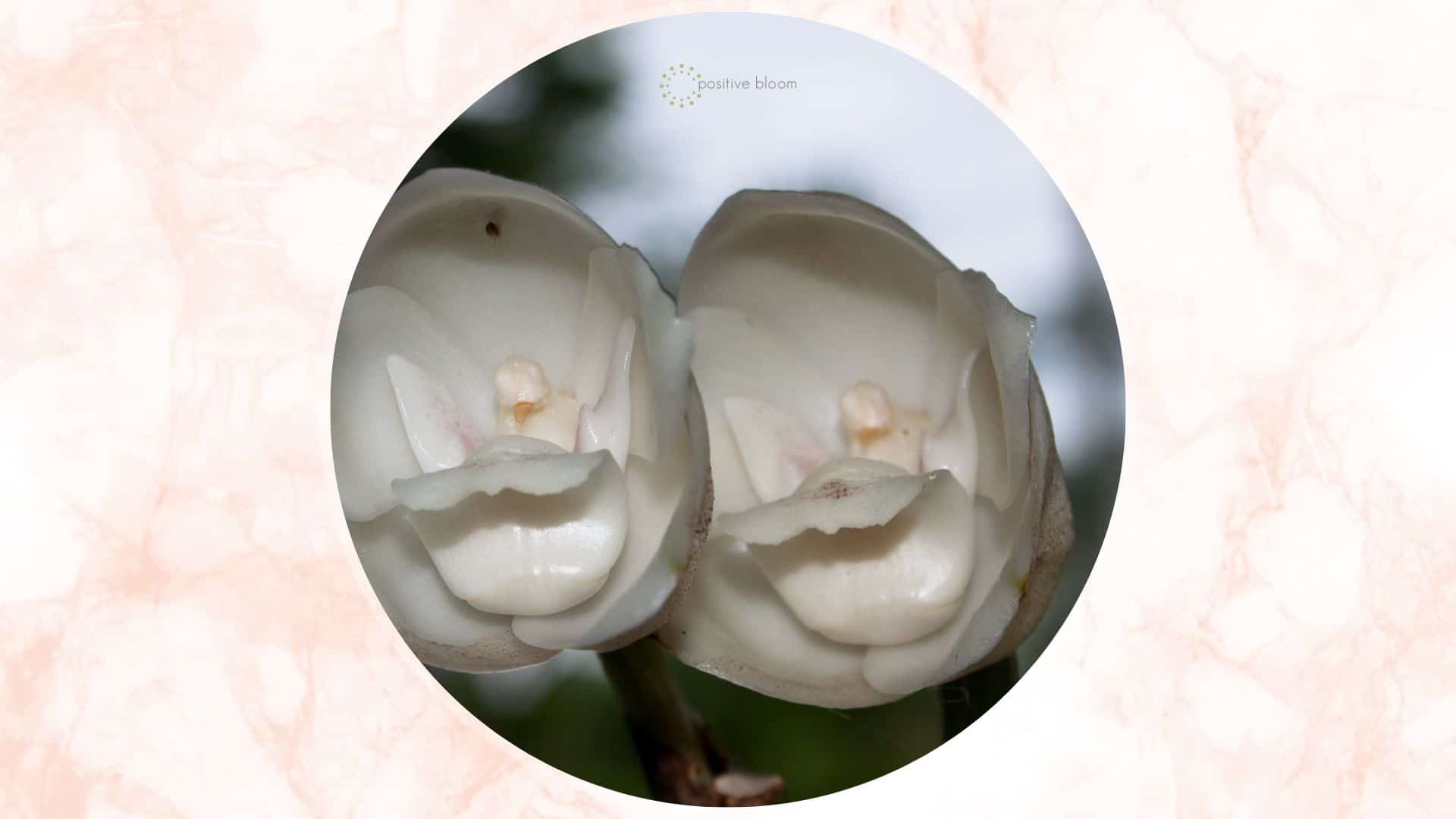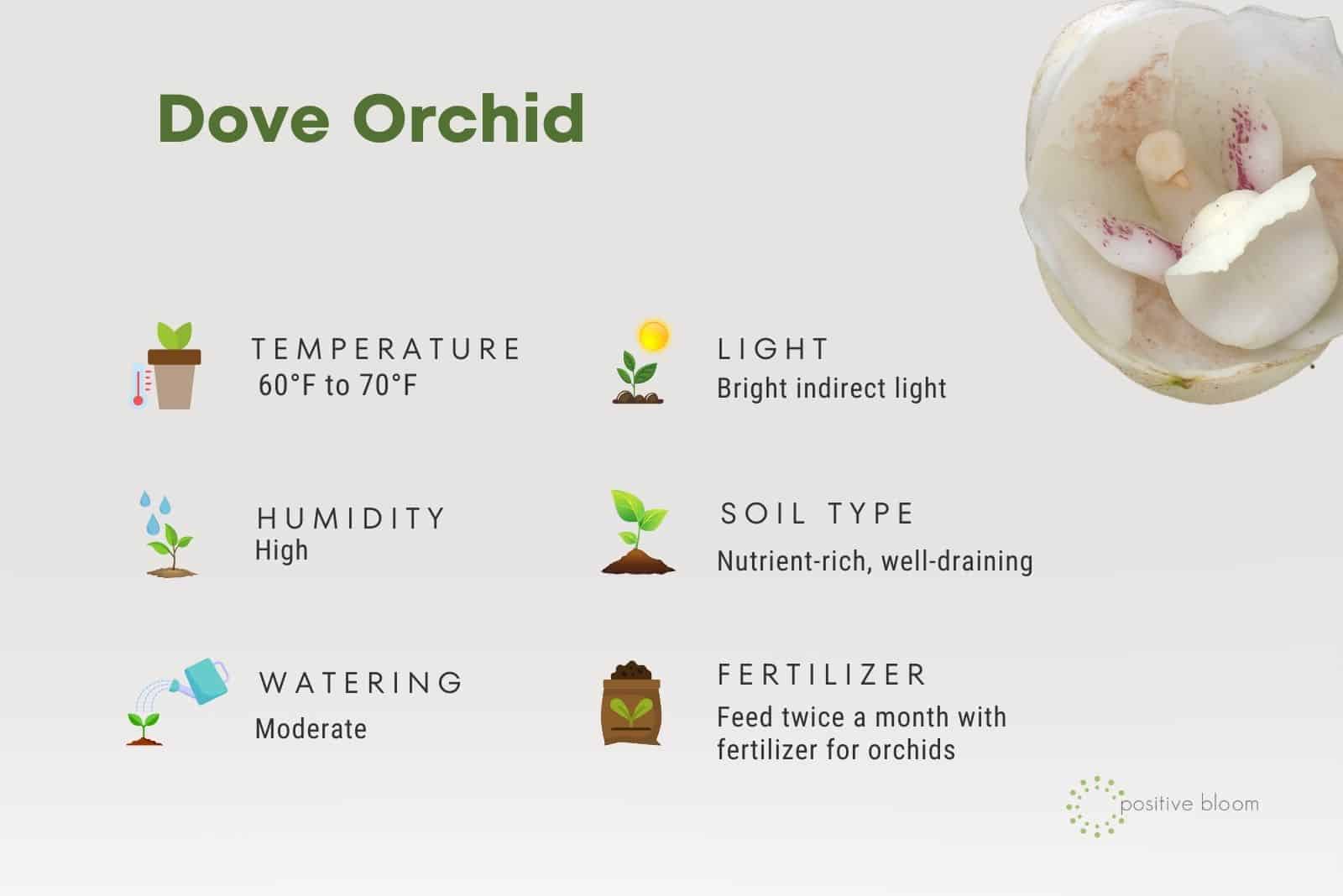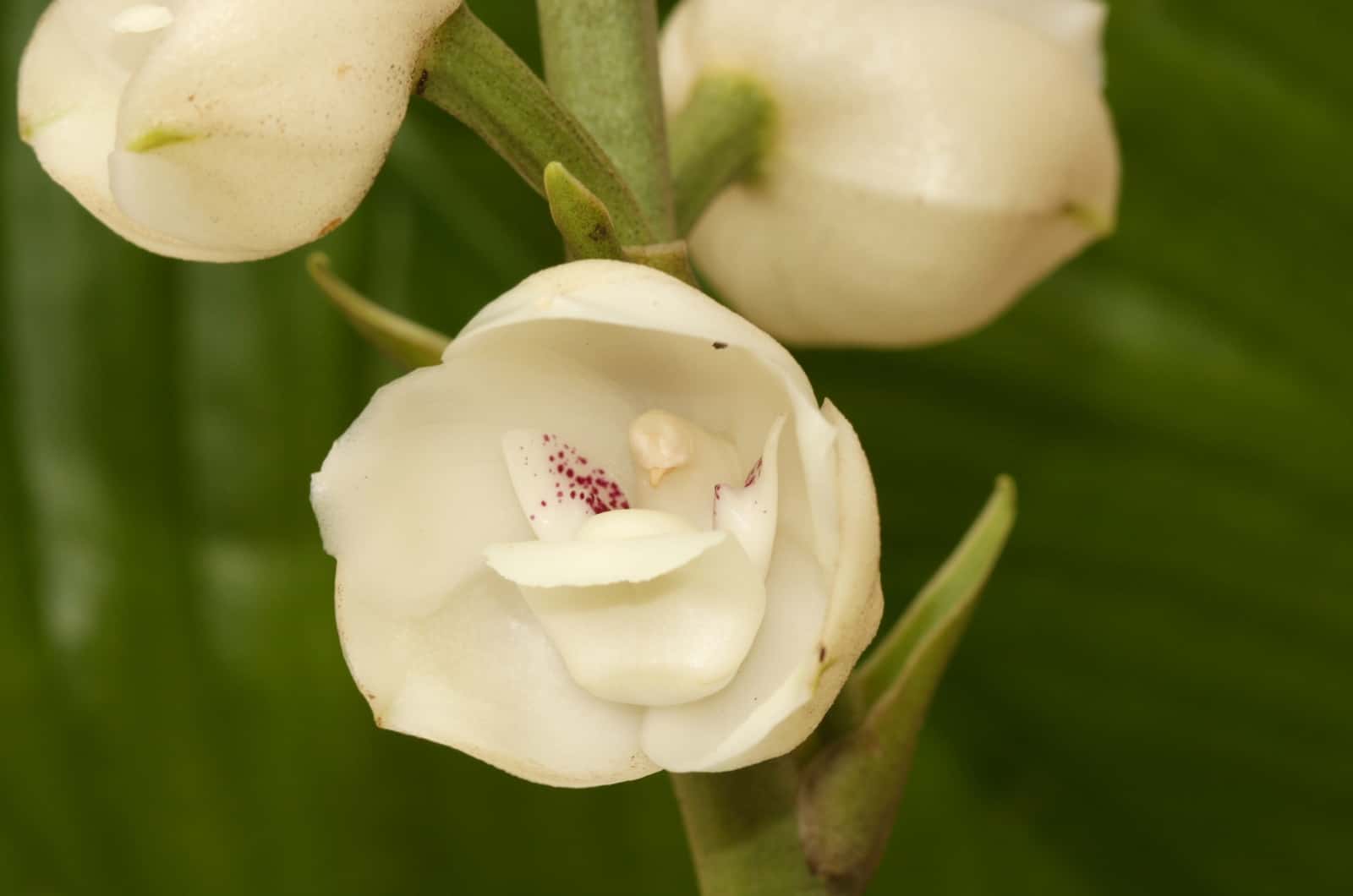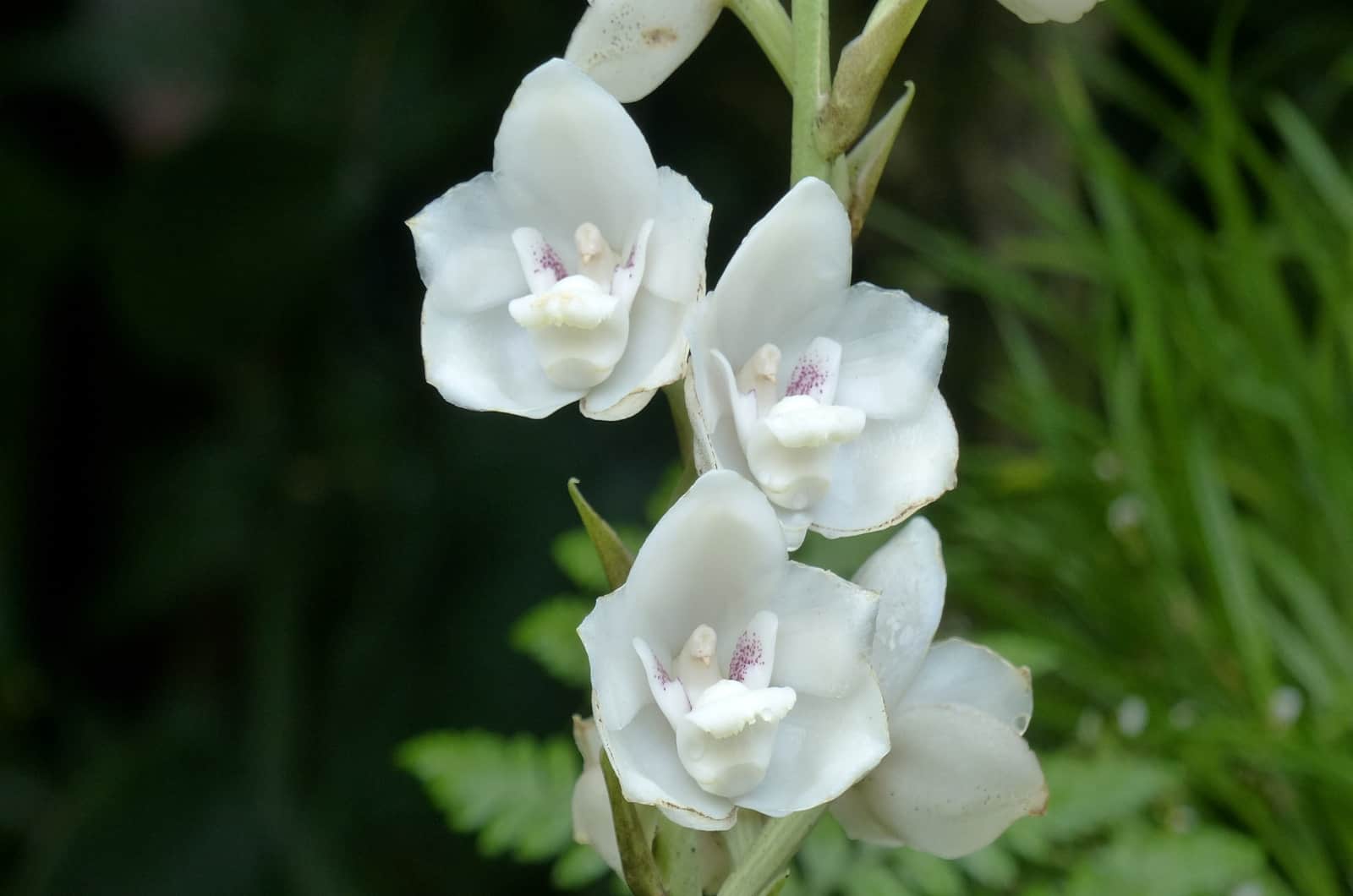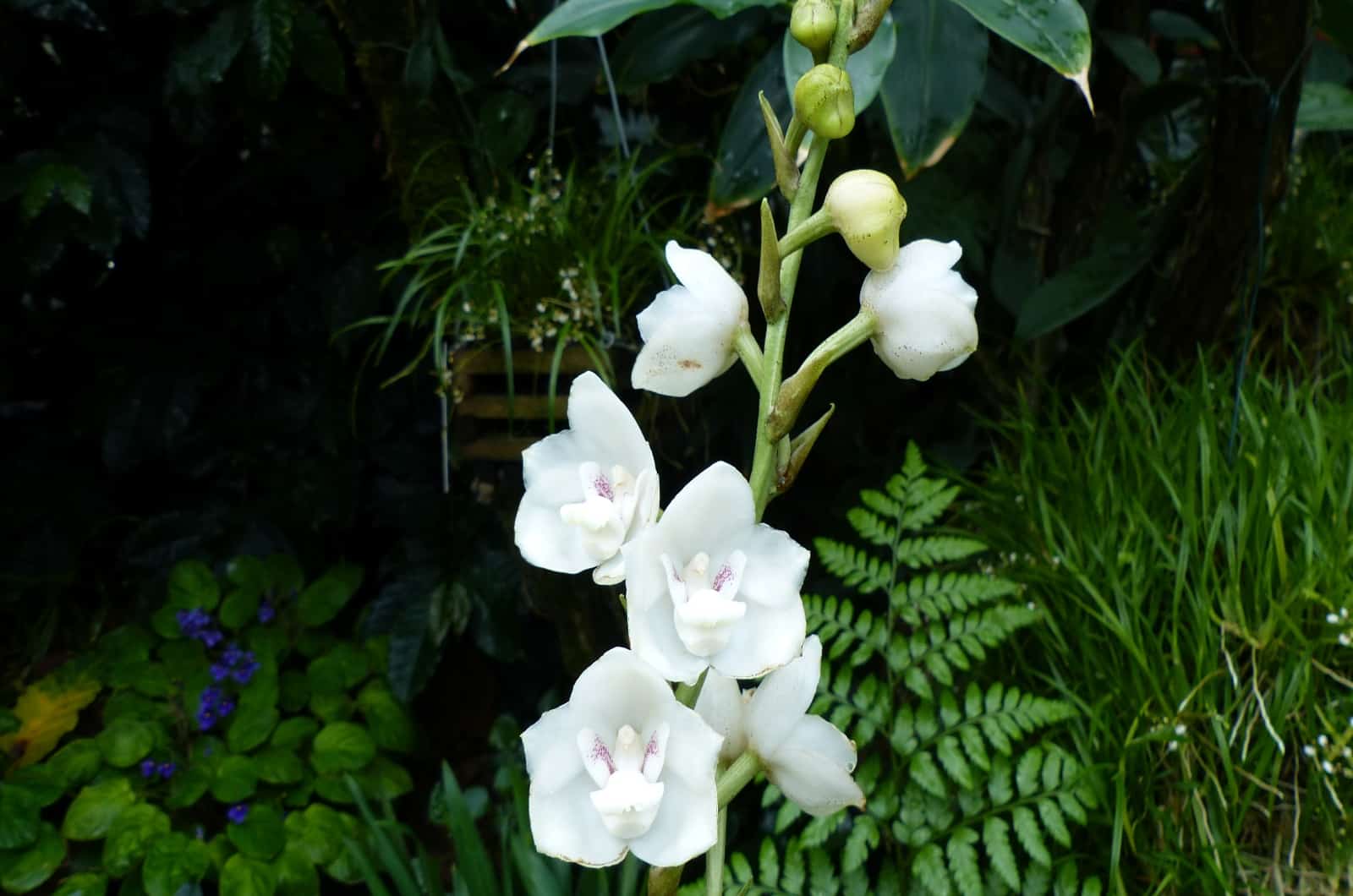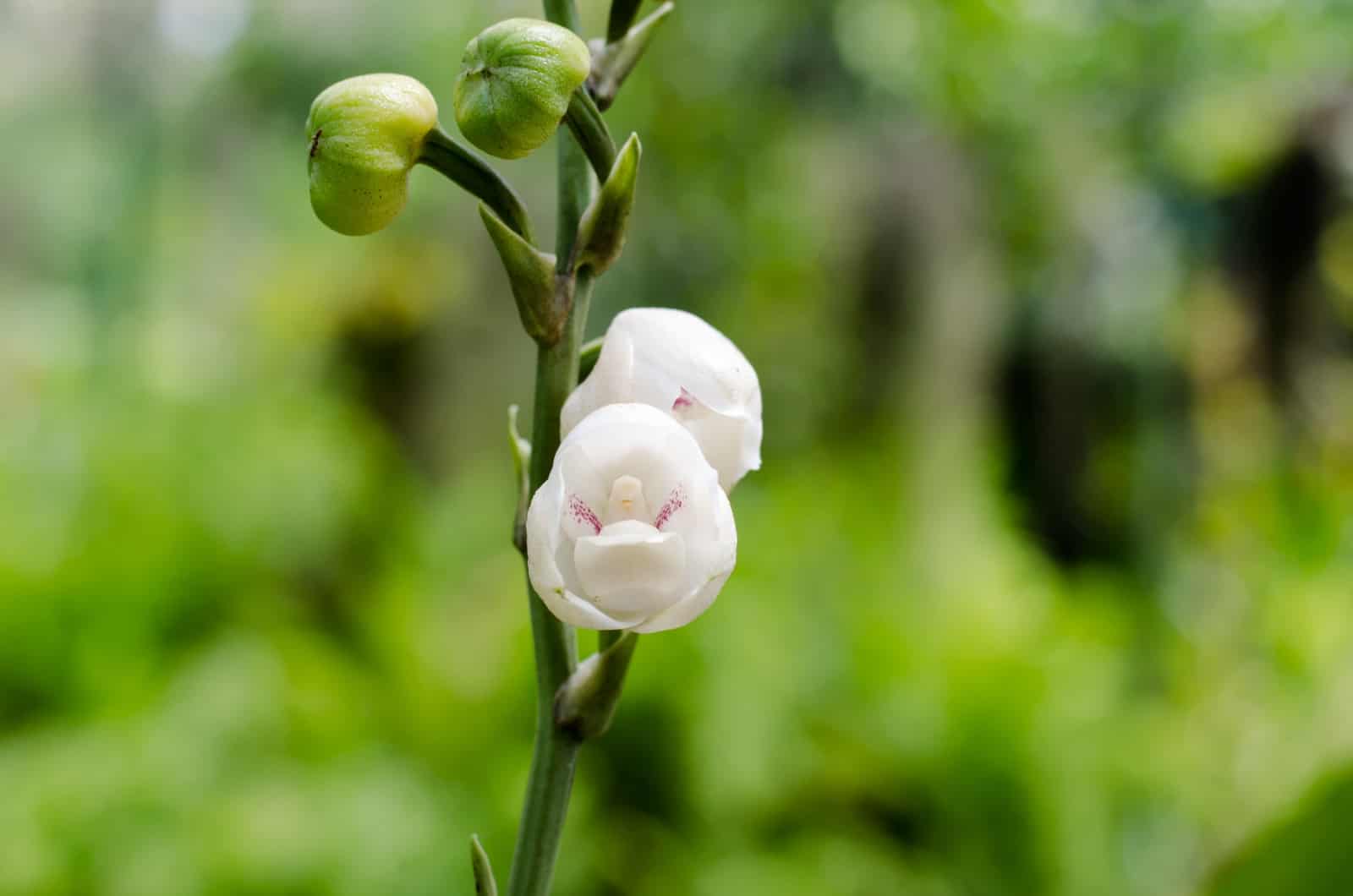Experienced growers are always happy to discover a new orchid species because no other flowering plant can compete with orchid beauty.
For novice growers, especially those who have heard how hard it is to maintain these plants, it’s another story.
We can’t deny the fact that orchids can be, to put it simply, fussy over growing conditions. But once you learn their care requirements and follow the guidelines, you shouldn’t have many problems.
There are over 30,000 orchid species, and today I’ve chosen the special one. Meet the Dove orchid, a delicate and rare plant that is the target of even the pickiest plant hunters.
In this article, I’ll describe the Dove orchid’s appearance and tell you more about its growth rate and habit, care necessities, propagation methods, and common problems with solutions.
Let’s start with the basic info:
[table id=648 /]
What Is The Dove Orchid?
The Peristeria elata develops from pseudobulbs and flowers with gorgeous white blossoms.
When you gaze inside the center of the bloom, you will notice the shape of a gorgeous, tiny, white dove. Blossoms have a waxy appearance and are grown on thick green upright stalks, each of which can bear 4 to 20 flowers.
Holy Ghost orchids are uncommon and exquisite plants grown for their distinguishing characteristic; a little white dove-like part in the middle of each flower.
This is the official national flower of Panama and probably the most wanted species in the plant world.
The blossoms are all white with 5 petals forming a veil around the dove shape.
They last for a pretty long time, and if you care for your orchid properly, you’ll get an abundance of blossoms during the growing season.
You need to be patient with the Dove orchid because it isn’t a fast-growing plant.
The Peristeria elata plant develops from pseudobulbs, which is another distinctive feature.
How To Care For The Dove Orchid
As mentioned, orchid plant care isn’t easy, and you’ll need to pay close attention to all the growing conditions. The care guide below will help you maintain a happy and healthy Dove orchid.
Light Requirements
Although keeping the Dove orchid on a windowsill may be attractive, bear in mind that light is essential for the correct development of this plant.
There are various light situations, and each has a particular effect on the Holy Ghost orchid plant.
For instance, your orchid will not be able to develop properly if grown in low light conditions; this is one of the major reasons why your orchid isn’t flowering.
Bright indirect light is the best choice for Dove orchid plants.
Perestria plants are native to tropical regions, and they receive filtered sunlight because of the dense foliage of tall host plants.
Your Dove orchid will develop healthily if kept near a window with eastern exposure.
If you can’t find a location with ideal lighting, you can always purchase artificial lights.
Watering Schedule
Overwatering and underwatering are the biggest enemies of these plants.
For example, overwatering causes root rot, a fatal fungal illness that can completely destroy your Dove orchid plant.
An exact watering schedule is difficult to establish because it depends on a variety of conditions, but Dove orchid plants are normally watered once per week during the growing season (spring and summer), and every 10 days during dormancy (colder months).
You might have heard of watering orchids with ice cubes. Although many growers claim that this method works, I strongly disagree.
My reason is simple; cold can stress orchids, so why risk it?
Here are 7 tips for watering a Dove orchid:
1. Only irrigate the plant once the top several inches of growing substrate are dry.
2. Focus on maintaining soil moisture; monitor moisture by inserting a finger or wooden stick in the soil. Alternatively, use a moisture meter.
3. Never irrigate Dove orchid foliage.
4. Bottom and top watering techniques are both suitable for orchids.
5. Water less frequently during the winter months due to lower temperatures; let the soil moisture be your guide.
6. Use room temperature water to avoid shock (the reason ice cubes aren’t a good idea) and irrigate with rainwater if possible.
7. Never pour all the water at once; your Dove orchid will grow best if you irrigate it gradually.
Humidity Requirements
These plants clearly like humid surroundings. Fortunately, there are numerous ways to increase humidity in your house!
Before I describe the methods, I have to mention once more that all orchids, including Dove orchids and Swan orchids, are delicate plants, so anything but ideal growing conditions might not be a good idea.
Holy Ghost orchids require humidity over 50%, so if the humidity in your home is slightly lower, there are some DIY methods that will suffice.
For instance, you can put a humidity tray (a shallow dish filled with pebbles and water) below the pot of your Dove orchid. It’ll only slightly increase the humidity, so it would be best if you also misted your Dove orchid and put it near other houseplants.
Dry air has a bad effect on orchid development, so you should keep your Dove orchid away from air conditioners.
The most straightforward option would be to get a humidifier. The best humidifiers on the market monitor and adjust humidity at the same time.
Temperature
These charming plants are quite sensitive to temperature fluctuations. This is actually one of the reasons orchid plant leaves droop.
As mentioned, air conditioning devices aren’t healthy for orchids, and the same goes for fireplaces, radiators, and cold drafts.
You should also avoid relocating your Dove orchid constantly, as this can quickly shock the plant. Winter is especially dangerous since these plants are not adapted to growing in cold temperatures.
The ideal temperature range for Holy Ghost orchids is from 65 to 70 degrees Fahrenheit.
Soil Type
Choosing the right growing medium for your Dove orchid will help you avoid many issues related to watering and nutrient deficiencies.
First and foremost, you must get a pot with drainage holes, which will let the excess water drain rapidly and prevent overwatering.
Because these plants do not grow in soil (they’re epiphytes), you must take special care to pick potting soil that closely replicates the conditions prevalent in their natural environment.
Soil types that are too loose aren’t the best choice for Dove orchid plants. I’ve mentioned that orchids, including the Holy Ghost cultivar, require constantly moist soil.
So, the soil needs to be moist and also well-draining?! The plant world is full of fascinating things, and you can actually have soil that is moist and drains well at the same time.
How? Simply mix well-draining and water-retaining materials to make a balance.
You can either purchase a soil mix for orchids or make your own. When I started growing plants, I was kinda afraid to try making my own soil, but it turns out that it’s the best idea ever and the sooner you start, the faster you’ll become an expert.
To make a perfect soil for your Dove orchid, mix peat moss, perlite, charcoal, bark, and coconut fiber coir. Thank me later!
Fertilizing Schedule
Orchids are one of the heaviest feeders in the plant world. The tricky thing is that orchids (from my experience) don’t like all-purpose fertilizers.
I think orchids want to show off in all respects. We can’t blame them, though.
We’ll provide them with literally anything just to see their magnificent blooms.
Store-bought fertilizers for orchids will ensure all the nutrients your Dove orchid needs. These fertilizers have lower concentrations of Nitrogen, Phosphorus, and Potassium, and when dissolved to half strength, won’t hurt your lovely orchid.
Believe it or not, eggshells make an amazing orchid fertilizer. I’m sure this isn’t shocking for experienced growers.
I always look for alternatives to store-bought fertilizers. I mean, there’s nothing wrong with them, and they’re probably more suitable for beginners, but why shouldn’t we use the eggshells we all have in our homes?
Crush the egg shells and add them to the orchid soil once a week. Trust me, your Dove orchid will appreciate it!
Pruning
Generally speaking, the Holy Ghost orchid doesn’t need regular trimming. Still, this is an excellent way to promote flower production.
A healthy Dove orchid will develop small eyes on the stem; cut the orchid off approximately half an inch above these eyes. The main reason for this method of pruning is to encourage the development of a new spike.
If your orchid keeps producing new roots and they start coming out of the potholes, it’s time to repot it.
Let’s see how to do it!
Repotting
If you have any epiphytic orchid species, you know that repotting can be somewhat challenging.
Some of my friends told me that repotting is one of the reasons they grow terrestrial orchid species. These plants are way hardier than epiphytic orchids, so their repotting requirements are lower.
When should you repot the Holy Ghost orchid? Well, you can leave this orchid rootbound for a while. As soon as you notice the roots poking out of the potholes and soil, the time for repotting has come!
I repot my orchids every two years even if the roots aren’t ‘everywhere’, because I kinda like to give them a nutrient boost.
Purchase a slightly larger container and prepare a sterile pair of scissors before you start repotting your Dove orchid.
Carefully remove your lovely houseplant from its current container, and then move it to a new one filled with orchid substrate.
Be very, very gentle when repotting orchids. Again, these are extremely delicate plants and you can stress them quickly.
Common Issues With Peristeria Elata
Now comes my least favorite part of plant care; dealing with the problems that may occur.
This is an expensive and rare plant, so it’s no wonder growers are so interested in their problems. It’s not like you can afford to replace a $100 plant (if you find it) twice.
So, what can go wrong when growing a Dove orchid?
Let’s find out!
Root Rot Disease
This disease has killed many orchids, and that’s why it’s essential to prevent it. This is actually the number 1 cause of a dying orchid.
Think of it this way; the plant parts above the soil surface are very sensitive, but the roots are way more sensitive.
The biggest mistake growers make is not learning the difference between moist and waterlogged soil.
Dove orchid roots need water to develop healthily, but if given too much, they’ll suffocate. Overly wet soil is the perfect place for fungus. If you overwater your Holy Ghost orchid, it will suffer from root rot.
How can you know if your Dove orchid has root rot?! The foliage is typically the first thing to display changes if something is wrong with the roots. Yellowing of Dove orchid foliage demands further inspection.
Mushy black or brown roots with a really bad smell indicates your Holy Ghost orchid is suffering from root rot.
So, what should you do? Repotting is probably the best way to save a Dove orchid with root rot. You need to take it out of its pot, cut off the infected roots with sterile scissors, and spray the root system with a fungicide.
Please use a new pot and fresh soil mix; the old one is most likely still infected, and the chances of your Dove orchid recovering if it gets root rot again are zero.
Discoloration
Dove orchid leaves display yellowing if the plant is infected, grows in poor lighting conditions, or lacks nutrients.
These are also common reasons an orchid stem becomes yellow.
Browning can also occur on Dove orchid plant foliage, so you should check sun exposure. These breathtaking plants won’t forgive you if you grow them in direct sunlight.
Wrapping Up
Rare orchid cultivars attract plant hunters from all over the world. This is the case with the magnificent Dove orchid.
It also goes under the name “Holy Ghost orchid” and is, unfortunately, an endangered species. If you ever come upon one, prepare to spend a lot of money.
I don’t want to discourage you, but it might be better if you choose another orchid species if you are a beginner or you’ve never cultivated an orchid before.
For more experienced plant parents, this guide will help you maintain a happy and healthy Dove orchid.
Until next time!

